Author of THE MONTH OF THEIR RIPENING, now available from The University of North Carolina Press
Don't wanna be here? Send us removal request.
Text
A new location
Dear Friends and Readers:
Food Pilgrim is no longer posting to this site, but has moved to:
foodpilgrim.substack.com
Please join me at this new home for posts.
0 notes
Text
Keen for Quinoa
Over the past 15 years, I have spent a fair amount of time riding in a car and enjoying the company of my colleague, the Reverend Dr. Sterling E. Freeman. Sterling is an itinerant preacher, social justice activist, deep thinker, and a consultant to various nonprofits and philanthropic foundations, his latter role being one that I share. We work together often. (Being the Food Pilgrim, I now confess, is my side hustle.)
As a onetime basketball standout at Davidson College, Sterling takes good care of himself. He does not eat beef or pork, and generally confines his consumption of chicken to his mother’s table in Little Rock, Arkansas, where he was born. Sterling eats fish, but how does he get enough protein? I asked him one day.
His answer was quinoa, and our conversations about this staple of his diet have led us to experiment in the Food Pilgrim Test Kitchen with this amazing South American seed that operates like a cereal or grain posing as a meat.

Uncooked quinoa. All photos by Donna Campbell
According to my trusty Oxford Companion to Food, quinoa is actually a relative of spinach, looks like lambs quarters growing in the field before blooming, and was “the principal grain crop in the Andes before the conquest of America.” The gorgeous flowering clusters on the plant look something like sorghum and hold tiny seeds--commonly white or red, sometimes yellow or black. The plants grow as tall as five feet. Quinoa flourishes at altitudes too high for maize and was historically grown in a belt extending from southern Columbia through Ecuador, Peru, Bolivia, and well into Argentina and Chile. Now it is being cultivated in the U.S., Canada, Kenya, India, Nepal, the United Arab Emirates, and in various European countries–England, France, Denmark, Sweden, The Netherlands, and Italy, according to an article in WOCATpedia. It tolerates drought well.
The Aztec and Inca peoples used quinoa in religious ceremonies and in stews, tortillas, and other breads. Following harvest, to prepare the seeds, the heads must be thrashed, winnowed to remove the husk, and the seeds washed in an alkaline bath to remove bitter toxins. The leaves of the plant can also be eaten as greens.
Flour made from quinoa seeds works pretty much like wheat flour, only the nutritional value is higher. The protein value of the seeds, says Oxford, “is roughly equivalent to that of milk.” Quinoa contains all nine amino acids essential to human beings and is high in fiber, protein, antioxidants, and magnesium, iron, and phosphorus. It is also gluten free.
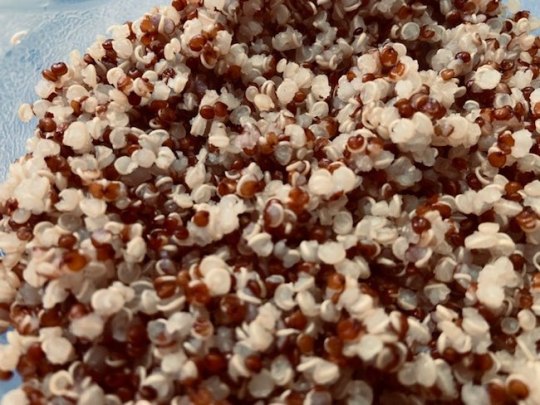
Cooked quinoa, red and white mixed.
Sterling explained to me that he first cooks up some quinoa—like rice, you rinse it and put it on to boil in water, let it sit, then fluff it with a fork. To the cooked quinoa Sterling adds some mashed up black beans, chopped onions and red bell peppers, feta cheese crumbles, and binds the concoction with an egg. Shaping the patties into slider-sized hamburgers, he fries them in olive oil.
In the Food Pilgrim kitchen, we substituted leftover field peas for black beans in our first batch of quinoa burgers and pinto beans in the next. That worked pretty well, but chef Donna Campbell felt that the egg binder was not quite doing the job. She bought and added some quinoa flour to the mix which worked well. We have since experimented with various additions of cumin, spring onions, carrots, and Hatch chiles in the patties.
Another batch took on an Italian flavor with parmesan cheese, basil, and chopped tomatoes. The feta cheese was a constant in all of these variations. Donna also now adds a bit of peanut oil to the olive oil, which allows a higher heat and creates a crunchier crust.
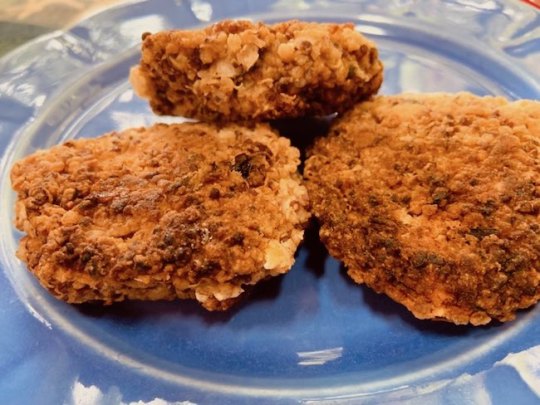
Crunchy quinoa cooked with some peanut oil
Using equal parts of red and white quinoa tastes better to me. Or maybe that is just an aesthetic preference for not-so-pale patties. Topping them with tzatziki sauce is also good with the cumin version.
If you are in a hurry, it is possible to buy cooked quinoa in a one-pound roll about the size of a package of polenta. Melissa’s Produce, out of L.A., sells these pre-cooked, hefty rolls that can stay at room temperature until opened. (Maybe you have seen Melissa’s pre-cooked lentils or black-eyed peas that come boxed and sealed in vacuumed plastic in the produce section.) Melissa’s quinoa is expensive, sourced apparently from France, and I’ve only found it at The Fresh Market, but this form is handy to slice and roll in your favorite additions when you are feeding a crowd.

Sterling Freeman, fellow traveler, powered by quinoa No matter how you create them, the cooked patties freeze well and reheat with a microwave. They are a filling addition to a standard green salad for lunch. Small patties go a long way. I’m hooked. Thanks, Sterling!
0 notes
Text
Appalachian Anomaly
At the annual Table Rock Writers Workshop last week, our special guest was Emily Nunn, a native of southwest Virginia and author of The Comfort Food Diaries, published in 2017 by Simon & Schuster. Emily read from the memoir in which she discovers that comfort food is less about the dish and more about its preparation. Food can be a way to express the deepest care without saying a word. Cooking for others can be more comforting than eating itself.
After her presentation, Emily, who also created the “Table for Two” column in the New Yorker magazine when she worked there, revealed a recent discovery—a wood-fired pizza joint in an unlikely place—Roan Mountain, Tennessee, the little village at the base of the high peak that divides North Carolina and Tennessee. Back in the 19th century, the winding road to the top, then very narrow and precarious, allowed traffic in one direction (toward Tennessee) in the mornings and then became one way toward North Carolina in the afternoons. Hardscrabble mountain people made the passage on foot, by hack, and on horseback as they could.
Eventually, in 1894, a resort hotel called The Cloudland was built right on the state line near the peak at 6,286 feet. Travelers could rent rooms with spring mattresses, copper tubs, and steam heat for two dollars a night, a fee which also included three meals. The state line was painted on the dining room floor at the Cloudland, because those seated in Tennessee could order an alcoholic beverage to go with their meals, but those who were on the North Carolina side could not. The Mitchell County (NC) sheriff reportedly came often at dinnertime to patrol the border, hoping some of those imbibing in Tennessee might accidentally stumble across the state line into North Carolina, presumably then being forced to pay a fine as steep as the slopes of the Roan.
Anyway, I digress.
Emily’s report of the Roan Mountain pizza was so evocative that Donna Campbell and I set out at week’s end to sample it. I have reported here on Pie on the Mountain in Lansing, NC, and Big Ed’s Pizza in Oak Ridge, TN. Both restaurants feature righteously fresh ingredients, including the now-ubiquitous Benton’s Tennessee Bacon. However, the pinnacle of pizzas for me is in Carrboro, NC, where Gabe Barker--the son of James Beard Award-winning chefs Karen and Ben Barker--makes ten-inch Neapolitan miracles at his Pizzeria Mercato.
Gabe has developed a handcrafted thin yeast dough that blisters to perfection in his gas-fired oven. The Mercato toppings vary with the season--organic vegetables and meats from the Carrboro Farmer’s Market across the street and the finest imports of Castelvetrano olives, Italian cheeses, and dried Calabrian chiles. Gabe’s most sublime creation to date is a grilled sweet corn and Gorgonzola pizza topped with razor thin slices of Serrano pepper scattered sparsely enough to open the sinuses without numbing the tongue. But I digress again.
On the way to Tennessee Donna and I studied the Smoky Mountain Bakery’s online menu and agreed on the Gourmet Veggie and the Hiker’s Surprise. All of their pizzas are more-or-less 12 inches and range in price from ten to twelve dollars with a maximum of twelve toppings. When we arrived on Cloudland Drive, we couldn’t see the restaurant from the road, only a bank of sunflowers just beginning to bend toward autumn.
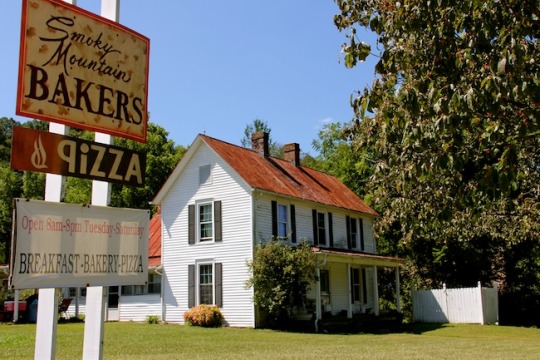
The sign out front
Ten years ago, Tim and Crystal Decker, both northern Californians and seasoned chefs, set up shop in a renovated barn to create this Appalachian anomaly. He is a European-style artisanal bread maker and she is a pastry expert. Their son Anton, a musician, also takes a turn in the kitchen.
If Gabe Barker’s place in Carrboro is urban chic—concrete floors and recycled timber tables and benches—this place is shabby seventies. No frills, no fuss. A throwback to hippiedom.
Breakfast is still under way when we walk in, served until 10:45—omelets, biscuits and gravy, pancakes, Belgian waffles, and pastries. The pizza oven is blazing by 11:00. The line soon runs out the door, and inside you find yourself waiting amid stock storage—cardboard boxes piled high and to-go pizzas already stacked in boxes on a low bench for pick-up beside the cashier’s station. A glass cabinet holds cherry pinwheels, lemon crinkles, coconut macaroons, snicker doodles, blueberry scones, red velvet sandwich cookies filled with cream cheese, banana bran muffins, and little loaves of pumpkin bread laced with walnuts and cranberries. A sign above these treats reads: “Stressed is desserts spelled backwards.” On the opposite wall, a metal baker’s rack on wheels is heaped with chocolate chip cookies and sweet rolls in plastic bags to go.
Eight young people are navigating around the flour-covered worktable in the kitchen. Two are rolling out dough, another is chopping toppings. Another slathers on tomato sauce while the young man closest to the hot maw of the oven wields the pizza shovel with grace. The rest take turns taking orders and swiping credit cards through nothing more than an iPhone.
Down the line, salads of frisee, mesclun mix, luscious cherry tomatoes, and random red beans sit in closed clam shells on refrigerator shelves for the taking. Three bucks per salad or two for five, DIY. Commercial dressings, however, come sealed in packets at the ordering window—the only disappointment, as it turns out. On down the line, self-serve fountain drinks with free refills are two dollars. There are a few tables inside; many more outside on the wrap around deck.
We place our order, take a number, and find communal benches at a long picnic table out back in sunlight dappled by a half-dozen black walnut trees towering over two sides of the deck. There is a vegetable garden, now waning, in the sideyard. Trees up the hill beyond are rounded sculptures of kudzu. Tendrils trail down and wave in the breeze. A sudden waft of woodsmoke heightens my appetite. We prepare with paper plates, napkins, plastic cutlery, and condiments, including red chile flakes and a shaker of parmesan that doesn’t taste like sawdust. All of these acoutrements are anchored against the wind in plastic bins on each table. The service is surprisingly quick.

Gourmet Veggie and Hiker’s Surprise. All photos by Donna Campbell
The Gourmet Veggie pie comes first--backroad-Italian rustic—chunky onions, generous bites of artichoke, a heavy hand of cheese. Yet, the dominant taste is salty black Kalamata olives and sweet sundried tomatoes—both flavors intensified by the oven’s heat. I suspect the tomatoes are local and dried on the premises. Fantastic.
Next out, the Hiker’s Surprise lives up to its name immediately. What is that crunch? Besides the saltine-like crust, there are deliciously browned chunks of walnut. Wow. The walnut pieces have been laid down on a light brush of pesto and then slyly covered by slabs of mushroom, more sun-dried tomatoes and caramelized onions, and the silky melt of Gorgonzola. The only thing I can imagine that might add to this magic is a handful of sliced red grapes spread and roasted over the top. (I mention this addition only to work in another pizza joint recommendation in Fayetteville, West Virginia, near the New River Gorge. Pies and Pints is the name—Gorgonzola and Grape is the pizza’s appelation.)
So, Miss Emily Nunn, you do not disappoint. These pizzas are a rare find, an unusual amalgam of flavors in an even more unlikely place. But as you told us last week at the writing workshop, the comfort often comes in the odd mix at the table. Or as she put it near the end of her book:
“Luckily, I had figured out that life was not a banquet at all but a potluck. A party celebrating nothing but the desire to be together, where everyone brings what they have, what they are able to at any given time, and it is accepted with equal love and equanimity.”
That’s how it was for us at the writing workshop--sharing what we had brought unvarnished, both our manuscripts and our personal stories, mostly told at table when we stopped long enough to eat. And so it was at this Appalachian anomaly—Californians making pizzas and pastries on the side of an ancient mountain. We declared our gratitude in the moment, delighting in the many tastes unfolding, bite after bite, on a not-exactly-round but satisfying crust.
1 note
·
View note
Text
Vidalia by any other name--not so sweet
I have been thinking about onions this week after sampling a sweet onion out of Upstate South Carolina that was new to me. It’s called the Winzo onion, and we found them on a family farm and produce stand in the town of Winzo.. The name might be short for wind zone. The magnolias grew very tall there, and It was so windy, the magnolias seemed to be chattering beside the farmstead. SC 9 also rides something of a ridge all the way from Mt. Croghan through Winzo and into the larger town of Pageland, where apparently these onions can also be purchased in the local farmers’ market. I wish I’d bought a whole bag to sample them more thoroughly.
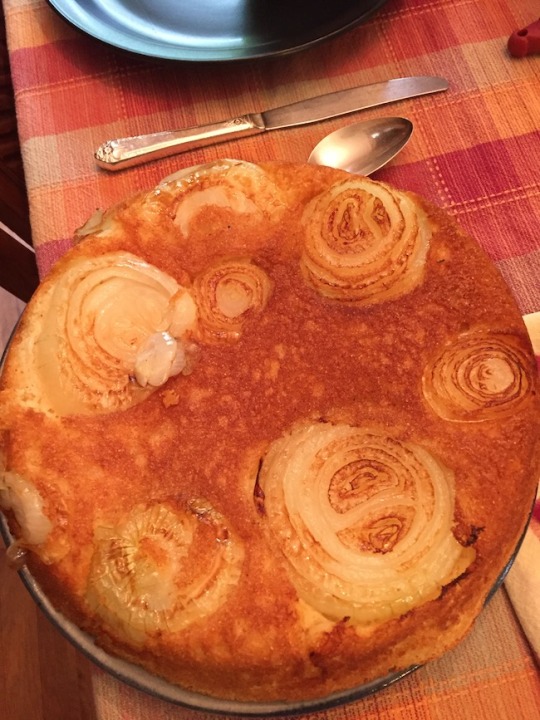
Vidalia onions cooked in the bottom of a skillet of cornbread with one interloper--the smaller Winzo onion from South Carolina (top middle)
Winzos are more evenly round, and delicate, and not as immediately sweet or large as the Vidalias I grew up eating, but the woman who sold them to me confessed they plant actual Vidalia onion plants in their fields. Winzo onions taste different, she said, because they grow in the local soil.
“Can you do that legally?” I asked. (I thought Vidalias were patented, but they don’t call them Vidalias in Winzo, so I guess it’s okay.)
“People here seem to love them is all I know,” the lady said.
Vidalia onions were an obsession in my Atlanta family in the 1960s, before onion production in the eponymous South Georgia town really geared up and went out of state with its premium product. My friend Sheri Castle just published a piece in Southern Living about Vidalias. She says, “At one time people had to go all the way to Georgia to fetch these onions, so prized that there are stories of women wrapping each onion in a lace doily or linen napkin and nestling them in the drawers of the china cabinet for safe keeping.”
I am sure that might have been true in upscale Buckhead, but in my family my grandmother, aunts, and mother stored their Vidalias in old nylon stockings that they knotted between onions and then threw that lumpy snake in the cool, dark garage or pantry. When they needed an onion, they’d take a pair of scissors to the stocking and liberate one at a time. Stored that way the onions would usually last, without sprouting, long enough for cornbread dressing at Thanksgiving.
Now Vidalias are stockpiled in “controlled atmosphere” warehouses that allow growers to store some 20 million of them for up to six months and stagger their release to markets all the way to the end of the year, according to vidaliaonions.com. At this website I also learned that Vidalia onions were granted legal status, (only legitimate if raised in a 20-county stretch of Georgia), and they were named the official vegetable of the state in 1986. The Vidalia Onion Hall of Fame annually inducts an individual who has played a significant role in protecting and promoting this Georgia treasure.
Softball-sized Texas Sweet onions, which do not compare to Vidalias in my opinion, were created after a million dollars’ worth of ag research was poured into them. Another sweet onion out of Walla Walla, Washington, also has its own band of fanatics who declare that the volcanic terroir in the Northwest creates a more complex flavor than Vidalia dirt does. They also note that Vidalias are hybrids, and Walla Wallas are not, having been imported to the region in 1900 from the island of Corsica, without any alterations over all these years. I wonder why don’t they call them Napoleonions?
What I love about Vidalias is their flattened shape. Most are wider side to side than top to bottom. This architecture, when cut into quarters from the top, produces thick, curved pieces pleasantly nesting inside one another. Raw, they are juicy, smooth, and immanently edible. For other purposes, you may cut the onion from side to side, producing large rounds of concentric rings. It is this preparation that Sheri Castle uses to make her special raw onion sandwiches.
This week, I laid out rounds of Vidalias (and one little Winzo slice) edge to edge in my iron skillet to bathe in a shallow bed of corn oil. I heated the skillet on the stovetop as usual, and then poured in my standard buttermilk, 2 eggs, and Martha White cornmeal mix. I do not measure. I add buttermilk until it looks like the consistency of my grandmother’s batter. Cooked in the oven at 400 degrees until brown, you let it rest for bit and release the edges with a knife if needed. Then flip the round onto a plate for Vidalia-upside-down cornbread. My kitchen smelled like Thanksgiving dressing for two days! The dish was something extra special to go with our turkey and white bean chili that night.

As for the Winzo onion, it carmelized wonderfully, but I found it lacking in flavor when I threw the small, raw rings on top of a salad later in the week. For some tender stomachs who are sensitive to the sulphurous burn of a traditional onion, perhaps the mild-mannered Winzo is a winner. I’m sticking with my sweet homies from Georgia.
0 notes
Text
Crumbling blue
As temperatures rise, an iceberg wedge salad can be quite appealing come suppertime. Now, after a recent pilgrimage to South Carolina, I have learned of a most worthy blue cheese for the topping. Please bear with this unexpected story.
The North Carolina mountains have long been a destination for Charlestonians and other South Carolinians seeking a reprieve from summer heat. The village of Highlands, where I spent the weekend, was among the most popular destinations. In the 1800s, however, getting to cooler climes from the coast required arduous journeys. Before the days of automobiles, the rail line north through the Upstate ended in Walhalla, South Carolina. From there, vacationers had to load up their luggage and hire horse drawn coaches. The jostling excursion up the mountain could take several days, depending on the depth of the Chattooga River at one of several crossings. The rugged switchbacks on rocky roads made for a dusty and dizzying ride.
Finally, in 1852, ambitious planners mapped out a path for the “Blue Ridge Railroad” that would connect Charleston to Knoxville, and ultimately, Cincinnati. Construction commenced from south to north the next year. The route would require 13 tunnels, the largest through Stumphouse Mountain, seven miles north of Walhalla.

Some 1,500 Irish people--miners and their family members--were brought to the mountain to tackle the deep blue granite with “hand drills, hammers, chisels, and black powder,” as a historical marker on the site explains. Aiming to create a tunnel more than a mile long and just wide and tall enough to permit a train to pass through, the miners first cut 16′ x 20′ air shafts to a vertical depth of as much as 200 feet into the mountain. Then they began excavating four horizontal tunnel sections, ultimately creating a 1,617 foot span underground. Legend has it that the immigrants also spawned a booming tavern business in their topside village called Tunnel Hill, where the workers would let off steam after their grueling shifts. The extremely hazardous duty paid less than two dollars per hour.
Blasting and drilling went on day and night. A million dollars into the project, South Carolina seceded from the Union, the Civil War began, the state’s economy collapsed, and the tunnel was never finished, though several efforts were made over the following decades to renew the project.
The ironically-named Mountain Rest, South Carolina, is now home to the “tunnel to nowhere” where a state park offers picnic and camping sites, a hiking trail to Issaqueena Falls (one of some 300 dazzling waterfalls in Oconee County), and a railroad museum.
Coming down Highway 28 from Highlands, Donna and I found the park, thanks to a friend who had mentioned its oddity. We found ourselves plummeting down a narrow corkscrew of a road from the park entrance through a lush canopy of hardwoods and flanked by blooming mountain laurel and ditch daisies. It was hard to imagine what the Irish folk must have thought of this rugged, almost-claustrophobic terrain when they arrived.

At road’s end, there is simply a parking lot and several narrative markers. Amid bird calls and an occasional swirling breeze, we walked up a steep, paved embankment about fifty yards. Ahead was the Stumphouse Tunnel, but well before we reached the opening in the rock, we were smacked in the face by a blast of cold air, as if someone had left the refrigerator door open. The chill hit like a wall of blue granite. The tunnel was dripping from above and leaching water down the sides. A sign had already warned visitors not to disturb the bats. I called out into the dimming light, and the echo was deep. I didn’t need to go any farther. The pulsing cold was delightful in the afternoon sun. We stood in awe of the long-ago labor.

But here’s the twist: In 1940, a Clemson College professor visited the abandoned tunnel and noted that the deep orifice maintained a steady humidity of 85 percent and a temperature of 56 degrees. This condition was a result of those vertical shafts the miners had created to enter the mountain’s rock from above. This climate, the professor suspected, would be perfect for curing cheese using the ancient method developed in the limestone caves above the village of Roquefort-sur-Soulzon, near Toulouse, in the south of France. Roquefort is one of the oldest known cheeses ever made and was favored by Charlemagne. The name is proprietary to France.
To make their own blue cheese, Clemson would not use French sheep’s milk, however, but chose Brown Swiss and Holstein cow’s milk. They developed mold strains perfect for the tunnel’s temperatures. Though milk shortages during World War II delayed the project, Clemson eventually bought the tunnel in 1951. They infused their local milk with mold cultures and transported it 30 miles to cure in the tunnel for six months at a time. From 1953 to 1956, the cheese was successfully manufactured, except during the summer months when conditions in the tunnel sometimes got a bit too warm. Eventually, Clemson’s food scientists replicated the tunnel’s conditions in their own air-conditioned ripening rooms in Newman Hall on campus.
Once again, the sad tunnel was abandoned until a coalition of conservation groups fought off a residential development plan and created instead a 40-acre conservancy that is now listed on the National Register of Historic Places and is managed as a park by the town of Walhalla.
Clemson is proud of its prize-winning blue cheese that’s distributed throughout the region. As they explain, “Each 288-gallon vat makes a batch of about 240 lbs, which is then salted, waxed and aged for 6 months. When it is ready, each hoop is scraped and packaged by hand. Each lot is kept separate, and strenuous record keeping assures quality at every step.” This venture is apparently not a money-making enterprise, but it is a rather distinctive marketing vehicle for the school. And it is delicious.

After reading about the tunnel’s short stint as a cheese cave, as modestly documented on the back side of one state historic marker, we immediately went to the nearest Ingle’s Grocery in Clayton, Georgia, and bought Clemson Blue Cheese in both crumbles and a wedge. Neither as harsh and stinky as a Gorgonzola nor as sharp and salty as Roquefort, Clemson Blue may well have been the first artisan cheese to come out of the South way back in the 1950s, and, like most everything from the region, it comes with a strange story attached. I prefer to think of it as Blue Granite cheese, in memory of the Irish miners.
0 notes
Text
Doing some dishes
Now that spring is here, Food Pilgrim has thrown it into high gear. This post is a compendium of dishes we have shared with friends over the last several weeks and over a number of highway miles. This story is one to hang onto if you are traveling anywhere near Knoxville or Oak Ridge, Tennessee; Auburn, Alabama; Kill Devil Hills or Highlands, North Carolina;
Let’s start with the Volunteer State. At the Tennessee Mountain Writers’ Conference in April, a group of workshop leaders almost got into trouble because we went out to lunch and made the poet Richard Hague late for his writing workshop. He was offering a session on writing poems about food, so we were just doing a little advance research. Richard presented a great workshop. Just as great were the pizzas we sampled for lunch at legendary Big Ed’s Pizza—a cavernous restaurant filled with historic photos, neon beer ads, and a frenetic team of teenagers throwing dough into the air, sliding hot pizzas out of gigantic gas powered ovens, and setting sliced pies onto red checkered tablecloths as far as the eye could see.

Big Ed’s Veggie Pie
This is a place without pretention. Logo T-shirts are eight bucks; caps are ten. Even though Benton’s Bacon is on the toppings menu, it’s really just about freshness. I am still marveling at how flavorful the veggie pie—starring chopped green pepper. And yes, the Benton’s bacon on the meat eaters’ pie was glorious. New York style, medium thin crust: I’d go back in a skinny minute.
Later, sitting in Richard’s workshop as he read Galway Kinnell on eating blackberries, I could still smell the Benton’s bacon on my fingertips and taste the tomato sauce tang at the back of my throat. Happy Day.
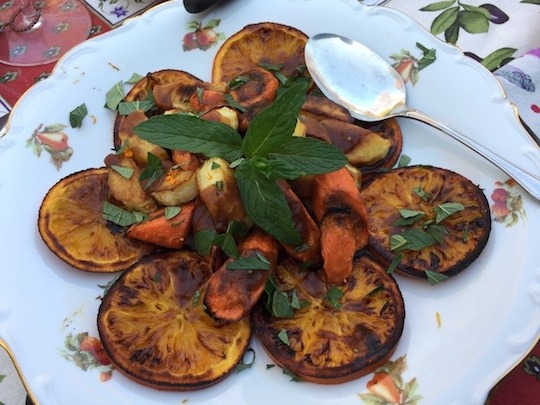
Jim Harb’s roasted oranges, carrots, and parsnips glazed with pomegranate molasses
On the way back to North Carolina from the writers’ conference, I stopped in Knoxville to visit my friend and consulting cook, Jim Harb. He prepared a feast for us in his garden that included the most amazing roasted carrots, parsnips, and oranges, glazed with pomegranate molasses and topped with fresh mint. Here is the big reveal of Jim’s secret ingredient: “I buy Cortas brand molasses. It's a commonly or widely available brand; a product of Lebanon. Two ingredients; pomegranate concentrate and sugar; that's all.”
Too many delectables to tell about in that one meal, but this dish knocked my socks off. I am ordering the molasses on line.

Cruze Buttermilk--the real deal
On my way out of Knoxville I also snagged some bottles of Cruze Buttermilk at Three Rivers Market, the Appalachian-owned food co-op that Jim favors. Cruze is real churned buttermilk made right outside of town with limited distribution. It’s not the cultured buttermilk you usually find in the grocery, which has been artificially acidified--no butter involved. Cruze is thick and almost chewy. I first heard about it from Jim and from Sharon Benton, bacon master Allan Benton’s wife, who said you could make biscuits without shortening if you use this buttermilk. That is true. And it makes a lovely cornbread. But I will save my words and suggest you watch this film by Joe York. Earl Cruze was made to make buttermilk and to star in this unforgettable interview.
Doing research for my next book, which I’ll talk about sometime in the future, Donna and I went to Alabama last week to see a dazzling array of rare, carnivorous pitcher plants. After visiting the Arboretum at Auburn University, we couldn’t resist a meal at Niffer’s Place, which is advertised as having “the best cheeseburger in Alabama”—a lofty claim in a state that apparently loves its cheeseburgers. Niffer’s is a student joint, a sports bar, and the menu starts with heft--up to two pounds of meat per burger--and toppings from pineapple to pico de gallo along with a half dozen kinds of cheese to choose.
My first clue to the overindulgence theme, however, came with the drink menu which leads with“Niffer's fan favorite fishbowls. All contain a generous mix of vodka, gin, rum, tequila and triple sec to which we juice it up with sweet and sour, pineapple, OJ and sprite. Make it uniquely yours by adding two more flavors: Strawberry, Blue, Mango, Cherry, Raspberry, Melon, Apple, Peach, Watermelon, Banana, Blackberry, Passionfruit or Wildberry.” Yuk. A young woman was actually drinking one of these bowls for a late lunch in the booth nearest us. I ordered unsweet tea.
Donna and I cautiously settled on sharing the cheeseburger sliders—two smaller versions of the megaburgers. They were indeed fabulous: hand-made patties topped with cheddar and charcoal grilled medium well (with butter, I suspect). Butter dripping into the charcoal would account for the smoky, homecooked flavor. Okay, so can I say they deserve the title, never having eaten another cheeseburger in Alabama in my whole life? There are two other locations--in Opelika and Lake Martin--the latter spot being where a James Beard winner has a fine dining restaurant that we tried to visit, but it was closed for part of the week.
And finally, in honor of soft-shell crab season, which is now beginning to wane at the NC coast, I am proud to share below another winning video by Donna Campbell, shot near Kill Devil Hills. It’s a crab shedding its shell. That night after the filming, we ate at The Kill Devil Grill, where the crab is super fresh, sourced from the very shedder shown here. Note the clowning crab at the end, ready for his closeup. It makes me laugh every time I watch it.
Thanks for reading, and please note that I will be at Half Mile Farm in Highlands, NC, next weekend where the chef is preparing ramps and taters and soft shell BLT’s for breakfast, a ramped up social hour, some oysters on the half shell, and a special drink with prosecco and plums in honor of The Month of Their Ripening from UNC Press. I’ll be talking and signing books with illustrator Carol Misner at Acorns on Fourth Street in Highlands from 11 am to 1 pm on Friday, May 17th. I’d love to see you there!
vimeo
0 notes
Text
Pilgrim on Book Tour
For a variety of reasons, it’s been a while since I’ve posted. Sorry for the hiatus. Most recently I’ve been traveling about twice a week to promote The Month of Their Ripening, my book on NC heritage foods. I spoke to a group of some 65 agriculture students at the University of Mount Olive in eastern NC last week. These students go to school where one of the state’s best-known products is prepared and packaged—Mt. Olive pickles. Though there might be the faint scent of vinegar in the air, strawberries are in the fields around town right now. My route also took me past scuppernong vines on either side of the road as far as I could see. No leaves yet on the vines, but spring has definitely come to that greening campus among the snowy dogwoods.
Near the end of my talk, one of the students questioned a comment in my chapter on goat’s milk. I had written about the prevalence of mechanized farming in relation to dairy cows, suggesting that goat’s milk by contrast was more likely to be gently produced and the milking done by hand. The student said that the phrase “mechanized farming” sounded scary and unfair. She told me that she and many of her classmates were headed to family farms after graduation, where the cows were actually treated quite well. She said it might be different elsewhere, but in North Carolina there are still many small, family-owned farms that treat their dairy cows like family.
Of course, that is true, now that I think about it. In Orange County where I live, my friends Portia McKnight and Flo Hawley of Chapel Hill Creamery make outstanding cow’s milk cheeses bearing the names of local landmarks. Hillsborough’s Maple View Dairy still uses recyclable glass bottles, offers whole milk, an almost chewy buttermilk, and the most luscious ice cream. Their farm stand is a destination that draws families by the car load this time of year to sample cones and sundaes while rocking on the front porch and observing the grazing herd before them. Other small farms in the region contribute to the milk produced by Durham’s long-running Maola Milk and Ice Cream.

Chapel Hill Creamery: where the cows are happy. So, I stand corrected. If you live in the Piedmont and want to learn more about these operations, the annual Piedmont Farm Tour, co-sponsored by the Carolina Farm Stewardship Association and Weaver Street Market, is April 27 – 28 from 2 – 6 pm. For a fee of $30 per car you can visit more than 40 farms throughout Alamance, Chatham, Durham, Franklin, Johnston, Orange, Person, and Wake Counties.
In January, I was the guest author at a colorful and scrumptious Middle Eastern spread created in support of Greensboro’s Scuppernong Books by patrons David and Susan Gutterman. The bookstore is a major organizer for the Greensboro Bound Book Festival held in May, along with a teen writing camp offered during the summer. Besides celebrating the scuppernong, our state’s official fruit, the eponymous bookstore on Elm Street in downtown Greensboro also serves food and wine and provides a cozy community space—really more like a living room--where visiting writers can comfortably share their work. The bookstore’s creativity in programming is unparalleled. Check out the schedule for Greensboro Bound in May.
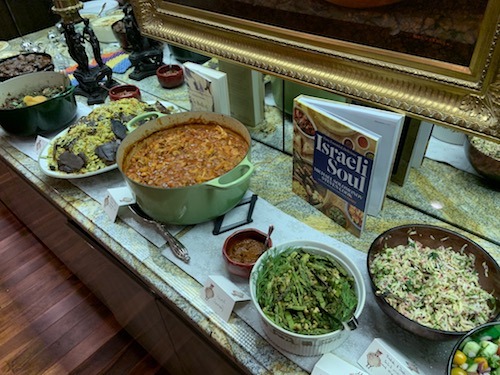
The feast in Greensboro for Scuppernong Books and Greensboro Bound Literary Festival
In February, I was touched when I arrived at Main Street Books in Davidson. The proprietors had prepared apples, persimmons, and goat cheese (also topics in my book) for patrons to sample during the presentation.
Soon I’ll be heading to far western North Carolina in Highlands for “The Month of Their Ripening Weekend” at Half-Mile Farm. I’ll be talking about spring foods—foraged and cultivated--while guests at the B and B sample dishes created from these ingredients, all crafted by the expert chefs at the Farm.
Botanical illustrator Carol Misner, who contributed her work to the book, will be demonstrating her painting techniques in the Garden Room. Photographer Donna Campbell, whose portraits of the fishmongers and farmers are also featured in the book, will be around to answer questions. Breakfast is likely to feature ramps, goat cheese, and prosecco flavored with muddled figs.

Garden Room at Half Mile Farm, Highlands, NC
Just this past weekend I was in Columbia, North Carolina, on the Scuppernong River, visiting with fishmonger Willy Phillips at Full Circle Crab Company. He said a small number of soft-shell crabs are already coming in from South Carolina because ocean waters are warmer than usual. (It will be May before Willy starts harvesting peelers.)
As for oysters, the peak season is winding down. While many new aquaculture operations around Pamlico and Beaufort were disrupted by Hurricane Michael, the new crop from Ocracoke, called Woccocan Oysters (so called after the native name for the island) have been delicious. It may not be too late to get a sample at restaurants across the state where Locals Seafood, a North Carolina distributor, delivers. We sampled some on the half shell a couple weeks ago—fresh, chilled, salty and perfectly saltine-sized—at Transfer Company Food Hall, a new venue, market and gathering place at 500 East Davie Street in downtown Raleigh. Created as a collection of vendors in a space designed for multiple forms of finger food with various spaces for sharing, meeting, drinking, and feasting, Transfer Co. is housed in what was the Carolina Coach Garage. There you’ll find Locals Seafood Oyster Bar, Che Empanadas, Benchwarmer Bagels (go early on weekends—the line is out the door), and Asheville’s prizewinning Burial Beer Company, a small-batch specialist. More food vendors will be opening there soon.
Chapel Hill Friends—I’ll be at Flyleaf Books at 7 pm on April 7th and at the Carol Woods Community on April 18 at 7 pm. In between I’ll be at the Blowing Rock Art and History Museum (BRAHM) at 6 p.m. See you somewhere perhaps? Happy Spring!
0 notes
Text
No Run-of-the-Mill Flour Here
It has been snowing across North Carolina from mountains to coast. It seems only fitting, then, that breakfast should involve a silky, white, homegrown flour that matches the fine grain of the falling snow. Donna has made her signature biscuits, about as big around as the bottom of a juice glass, which we promptly split open, top with thin rags of country ham and douse with red eye gravy. They are thin and crispy, bottom and top, but they hold the gravy and stay steady on the fork.

Donna’s crispy biscuits
As we eat, I count 15 species of birds outside—from downy woodpeckers to greedy bluebirds to brown-headed nuthatches to yellow-green pine warblers. They perch and parry with one another in the drifts of snow before devouring the seed and suet I have put out for them. For my last biscuit, I leave off the ham and gravy and dress it with a compote of figs and rhubarb, preserved with the juice of a squeezed lemon.
This is the second time we’ve had biscuits prepared from a classic, old-fashioned flour that is preservative free and made from soft red wheat grown mostly in Yadkin County. Boonville Flour and Feed Mill is about 45 minutes northwest of Winston Salem on Highway 67. If you are on a Yadkin winery tour, Boonville is a convenient stop. This rolling part of the state is steeped in Native American history, too. The crossroads at Highways 601 and 67 bring together the original trading routes of the Catawba tribe.
A week ago, when Donna Campbell and I walked into the retail store that fronts the mill operation, Cindy Howell, who minds the store, was taking a phone order from southern California. That got my attention. Word is clearly out on this special southern kitchen staple.

Boonville Flour and Feed Mill also produces all purpose flour, corn meal, and grits
We first heard about Boonville Flour more than a year ago from Sharon Benton, the wife of Allan Benton, whose deeply flavorful Tennessee smoked bacon and hams are favored by top chefs across the South. Sharon said Boonville Flour mixed with Cruze Buttermilk (only available in Knoxville) always makes the best biscuits. Though we tasted the thick and delicious Cruze Buttermilk back in the fall when weekend guests brought some along from Knoxville, it took us a while to get to Boonville for the flour.
Used to be, many towns had their own local mills that provided corn meal, grits, and flour to local customers. Not so much anymore. Even among the giants of southern milling, things have changed. One of the regional standard bearers, White Lily, also of Knoxville, Tennessee, was bought out by Smuckers in 2006, and the company closed the Tennessee plant two years later. Southern Biscuit flour, still on the market, originated in North Carolina in 1935 at Maiden Mills in Newton, near Hickory. This large milling operation is now owned by a company called Renwood and can mill 750,000 pounds of flour per day. They sell their mass-produced product to grocery chains across the region.

Bags from by-gone mills
Other smaller operations such as Dellinger Mill, established in 1867 in Mitchell County near Bakersville, mainly exist to demonstrate old fashioned stone milling techniques to visitors. Dellinger’s water-powered mill is the last of its kind in operation, the owners say, and a bag of cornmeal or grits from there is $10.00.
The Old Guilford Mill, near the Piedmont Triad Airport, was first established in 1767. The water-powered mill has been managed by a succession of owners. Today’s product line includes a range of muffin, pancake, and biscuit mixes that sell for under $7 a bag. Lindley Mills of Graham, NC, established in 1755, is now best known for its trendy organic whole grain wheat, rye, spelt, and kosher flours which sell in the $7 range per two-pound bag.
So, there’s really nothing quite like Boonville Flour that I can find in North Carolina. Sammie Phillips, now 94, bought the 19thcentury mill in 1979, and son Eugene and daughter-in-law Vicki Phillips now run the operation. The storefront at 203 Carolina Avenue South dates back to 1896 and is decorated with an array of local feed and flour bags that recall the earlier profusion of smaller mills like this one. The store also carries a variety of old-fashioned stick candies, 100% scuppernong juice from the local area, and some very fine local country ham.

Eugene Phillips runs the Boonville Mill
Workers in the Boonville mill might grind and bag around 1,000 pounds a day. They don’t sell to grocery chains, but they do sell to a number of restaurants and small markets in the vicinity. Cindy Howell has been at the register for more than eight years and says she now takes orders from all 50 states. She recommends keeping the flour in the fridge or freezer since it comes pure, without preservatives. “Once people try it, they come back for more,” she said.
We did—for holiday presents this season and for biscuits in the Campbell family’s traditional Christmas morning breakfast. Unless there is a bad year among local wheat growers, Howell tells us, you can be sure the Boonville products come from wheat and corn grown in the area, only occasionally supplemented by Ohio wheat. Self-rising and all-purpose baking flour, corn meal, and grits are the mill’s main products. They also carry livestock feeds.
And by the way, the Boonville prices are old-fashioned, too: a two-pound bag of the self-rising flour is $2.00. The grits are $3.00, and the self-rising corn meal is $4.00 a bag. They are open for business Monday through Friday 8 am to 4 pm.

0 notes
Text
A Pressing Matter: Mountain Cider
This Friday, November 16th, in the village of Lansing, North Carolina, the Molley Chomper Cidery (165 Pine Creek Road) will celebrate the end of cider pressing for the year and simultaneously release their first cider of the fall season—Old Orchard Creek Blueberry. The Cardinal Burger Wagon will be on site with hot food and The Worthless Son-in-Laws, a band, will make music. The party starts at 6:00 pm and continues until 9:00. Lansing is 16 winding miles north of West Jefferson, NC, and if you ride another 16 miles north from Lansing, you could find yourself in Virginia, near Grayson Highlands State Park.

Molley Chomper Cidery, 165 Piney Creek Road, Lansing, NC. Photos by Donna Campbell
Donna Campbell and I recently paid a return visit to the cidery, arriving just as owners Tim and Kate Arscott were washing up the premises from a pressing of apples. It takes four months from pressing to bottling their finished products. They make especially delicious hard ciders that are subtle, bubbly, not overly sweet, and easy going down.
This season has been a spotty one for heirloom apples in this part of North Carolina because of a very late freeze on the front end of summer and the two hurricanes and excessive rain that played havoc with some orchards in September. Disappointing leaf color, I might add.
But regardless of rain or storm or frost, Molley Chomper remains loyal to the Appalachian heirloom growers who are their neighbors in North Carolina and Virginia--the closer the orchard to the cidery, the better. Since moving to Ashe in 2012, the Arscotts have worked closely with Big Horse Creek Farm, run by their friends Ron and Suzanne Joyner, who are featured in my new book, The Month of Their Ripening.
For the third time since they began this enterprise, they have also tapped into the blueberry and apple harvest at nearby Old Orchard Creek Farm, where owners Johnny Burleson and Walter Clark have a booming pick-your-own-blueberry business set high in a steep mountain bowl with old, heirloom apples sloping down below the blueberry grove toward the creek bottom. It’s a sight to behold.
Less than a decade ago the Arscotts were living the big city life in Atlanta. Tim was a successful management consultant to financial institutions, and Kate was a nonprofit fundraiser. When their first child was born, they began looking for rural property. They eventually bought their farm in Ashe County. The property already had some intriguing old apple trees. They named the place Bent Apple Farm, but soon realized they could probably not make a living growing apples, even though they have planted hundreds of trees each year since they’ve been in residence. The idea of making cider seemed much more promising. Get this, they gave up successful careers, moved to this remote holler and then figured out what to do. That is plain gutsy.

Kate Arscott in the Tasting Room at Molley Chomper
The Arscotts started experimenting in the back bedroom of their farm house, pressing cider from apples on the farm. Their first batch was called “Mountain Maelstrom,” inspired by the chill winds that blow through the holler and rattle their windows.They still make the blend today.
“I was naïve coming from Atlanta,” Kate explained. “I also wanted to raise goats. I was going to milk them, make cheese, do the whole back-to-the-land thing. Then Suzanne Joyner said, Don’t do it! Goats will eat your apples. They will escape from any enclosure and destroy whatever they can get! So Molley, our mascot, is a made-up goat.” Kate smiled and pointed to a handsome steel sign with the goat’s happy figure punched out of the metal, perhaps as if she chomped her own image in steel.
Tim continued working long distance with his consulting clients in those early years and bankrolled the start-up until last September when he finally moved full time into the cider business. His mother also retired last year and moved to Ashe County to help with their two children. This year the youngest started school.
“The pace of our lives is not much slower than it was in Atlanta,” Kate said. “But it is much more fun and fulfilling. At the beginning it was just us doing everything. Now our accounting goes to an accountant, and our employee, Nick, who is strong and can move big containers around, is learning cider making.”
Molley Chomper is already outgrowing the former library building at the Old Lansing School where they are headquartered, and the Arscotts are looking for a storage facility for their finished products. Every year they have sold out every bottle they’ve made. They now ship cider as far east as Raleigh, as far south as Charlotte, and were recently invited to sell their bubbly in the highly competitive cider market of Asheville.

All original names and consistent flavors.
The family has actually put Lansing on the foodie map. A gourmet pizza restaurant, Pie on the Mountain, is now owned and run by Kate’s brother, Matt Cordell. Following the Arscotts�� practice in their tasting room, Cordell sources products from local vendors as much as possible, including Ashe County’s Rose Mountain Butcher and Farms, Vannoy Hams, Stickboy Breads, and craft beers from New River Brewery. He also only sells soft drinks from the local Dr. Pepper bottling plant, a big employer in the county. Cordell also uses a few well-known small batch products from outside Ashe such as Allan Benton’s Bacon, from Tennessee.
This year Molley Chomper bought some 1200 bushels of apples to press. Next year Kate says they plan to double that amount and reissue a special cider made from Ashe County’s other signature crop besides Christmas trees—the pumpkin.
“This cider is made from Ashe County pumpkins without any other flavoring,” Kate explained. “It’s not like something that is made with pumpkin pie spices that make you think it’s pumpkin. We press and ferment the juice, and then keep it in bourbon barrels. We’ll release it this spring because it ends up being a very light, melon-y cider, and it was a big hit last year, so we’re upping the production. It’s an heirloom pumpkin that is specific to our cidery. People asked for more.”
“Porch Swing” is their summer cider, which I have enjoyed since my first visit more than a year ago. Then there’s “Hopped Molley,” which is made with hops. “The Dregs” is a blend from ciders still in the cellar at the end of the year. Others—"School House” and “Bent Apple”—are consistent favorites.
“We make varying amounts of each cider depending on what apples are available,” Kate said. “We press them fresh every year, and it’s the combination of apples and yeast that makes the flavor and aroma distinctive. Of course, the apples change every year. We may use 30 to 40 varieties per blend and vary the percentages according to the quality of the crop. We have learned our yeasts-- how to test and taste them to make sure that our core flavors remain the same.”
The Arscotts took intensive chemistry classes from a British yeast expert who taught them how to assess the juice by sampling and blending them in beakers. They also learned how to evaluate the health of various yeasts. They now have eight large stainless storage tanks in their facility, and they pasteurize and label all the bottles in house, with the goat logo printed on every bottle.

We talked some about cider made from other fruits—the possibilities of serviceberries and persimmons--but getting quantities of some odd ingredients can be difficult. Molley Chomper has yet to bottle “Big Horse Creek” again, a signature cider they blended in their first year from Ron and Suzanne Joyner’s apples. Fingers crossed that the Joyners’ apples will have a good year in 2019. “People really loved that one.” Kate said.
If you visit Lansing for the release party, don’t miss the chocolate gravy served for breakfast in Warrensville nearby at The Whistle Stop Cafe. Chocolate gravy is not something you find just anywhere in North Carolina for breakfast. James Beard winner Ronni Lundy, the writer who gave us the book Victuals, can tell you that.
0 notes
Text
High Country Tenderness
It’s a dramatic and spirit-lifting drive along the six-mile stretch of NC Highway 18 from Cumberland Knob Recreation Area in Surry County, NC, to the community of Ennice in northern Alleghany County. The highway unrolls to the west like a ribbon along the ridgetops, almost in sight of the Virginia state line. To the south and west, long, peaceful views of grazing cattle and symmetrical fields of boxwood and Christmas trees undulate toward Bullhead Mountain, a landmark on the Blue Ridge Parkway. Beyond Ennice, the road runs down to the county seat of Sparta, where I was headed for a weekend of food and festivities associated with my book, The Month of Their Ripening. I was hosted by Alleghany Writers, a scrappy literary group with a big vision in this small mountain county populated by hard working farmers and joyful retirees. Some residents qualify in both categories, as did the two families I met on the first day of my visit.
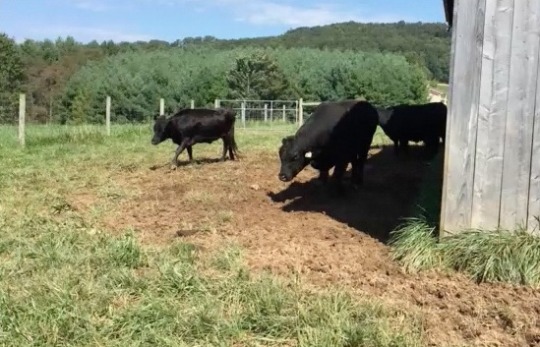
The visiting bull (right) on the move to a different pasture
Before moving permanently to Alleghany County, Ricky Brown lived in several NC cities as a senior bank executive. He and his wife, Kim, had been childhood sweethearts in the eastern NC town of Robersonville in Martin County where cotton and tobacco are the primary products. The Browns moved into the cattle business when their daughter Sara declared she wanted to become an organic farmer. While Sara went off to study at The Farm School in Athol, MA, followed by a volunteer stint for Heifer International, Ricky took early retirement and found some 175 rolling acres that had formerly been planted in Christmas trees. Then Kim’s sister Lynn Perry and her mother, Doris Perry, joined the Browns in the mountains.
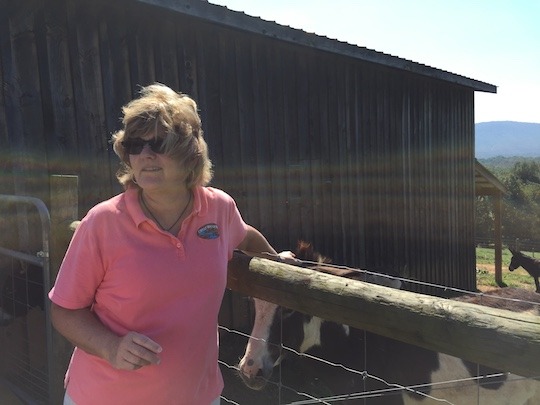
Chilly Water Farm’s Kim Brown and Levi, a standard donkey
Today Chilly Water Farm raises Dexter and Angus beef cattle without hormones and antibiotics. The herd feeds exclusively on grass and hay, rotating every two days through a series of paddocks that keep the pasture grass thriving. Each year Chilly Water sells a limited quantity of high quality steakburger meat by the pound to local customers and to select Winston-Salem restaurants.
“The burgers are made from everything but the short ribs and soup bones,” Kim explained, as we set out toward the chicken pen. (Chilly Water also sells eggs and uses chicken fertilizer for the garden.) “We recently got rid of the rooster,” Kim continued. “He drove the girls crazy. They didn’t need that. We are all about harmony here.” She grinned.
The farm menagerie involves several dogs, including a Jack Russell terrier named Opie, a standard donkey named Levi, and eight miniature donkeys, all female, who keep him company.
“These animals are for nothing but peace and joy,” Kim said, as the small herd trotted over to greet and nudge us for head rubs along the fence. Nearby, Little Jack, a rescue goat, was penned with his companion, Watson, also seeking an audience with the humans. More goats played up the hill in a separate pen near an heirloom apple tree that was loaded with yellow fruit. Kim explained that only the goat named Elvis could possibly be a candidate for a meal, leaving us to wonder about his offenses.
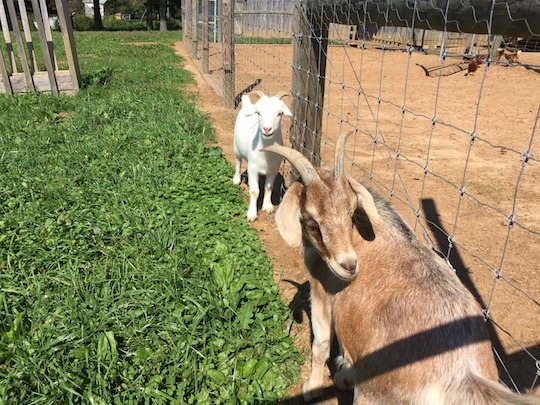
Watson in foreground and Little Jack, the rescue goat
After paying our respects to these “house” animals, sister Lynn joined us as we climbed onto a four-seat gator and sailed across the pristine fields to get a closer look at the horses and cattle down in the holler, including an enormous visiting bull who quickly showed us his stuff. We laughed as Lynn put on her mucking boots and hopped off the vehicle to lead the herd through the gate to their next grazing destination. Then we shot forward again, bouncing and angling downhill and then uphill again on a washed-out trail through dense white pines, mature hardwoods, and an occasional Norwegian fir.
When we stopped to observe the pond from the far side of the woods, the sisters reminisced about their grandmother’s unforgettable molasses cake recipe that they had asked her to share with them as her health was failing. The ingredients, as it turned out, were the last words she spoke to her granddaughters. “But when we made it, it didn’t turn out like we remembered,” said Lynn, now amused by the memory. “I think she maybe didn’t give us all that the cake called for.”
“Of course, she never measured anything anyway,” Kim added. “Just a pinch of that and a spoonful of this.”
Back at the house, Ricky had cooked juicy and tender steakburgers on the grill and Doris set out a buffet of green beans, okra, fresh sliced tomatoes, stewed apples from the tree outside, and crisp homemade pickles and jalapenos. After such a feast, I hated to leave Chilly Waters, but I presented my kind hosts with a signed copy of the book and headed out to my next destination.
***
Frances Huber grew up in the toney Buckhead section of Atlanta but started coming to Alleghany County for family retreats as a ten-year-old. Now, just past 80, she is raising Angus breeding stock. She used to sell her cattle for beef, but today she raises the original Angus that have shorter legs and carry more meat than their big-boned, genetically modified relatives. “Now I don’t have to apologize when I sell them off,” Frances explained, “because they are not going off to be processed but are headed for breeding.”
Huber, assisted by a full-time farm manager and an occasional student intern, also raises all-natural, forest-grazing hogs that were lolling around the edge of the woods alongside the cattle as I made my way down the treelined drive to the two-story frame house that she and her late husband, Andy, built in the 1990s.
Long before her organic farming adventure started, Frances read Rachel Carson’s Silent Spring and developed an interest in holistic medicine. With Andy, who was a Cornell graduate in agriculture, the Hubers bought this abandoned dairy farm in 1994 and raised hay and horses without the use of chemical fertilizers, herbicides, or pesticides. “The weeds will tell you what’s wrong with your soil,” Frances explained. She taught herself how to correct deficiencies in the dirt with natural applications of minerals such as gypsum to get the pH right.
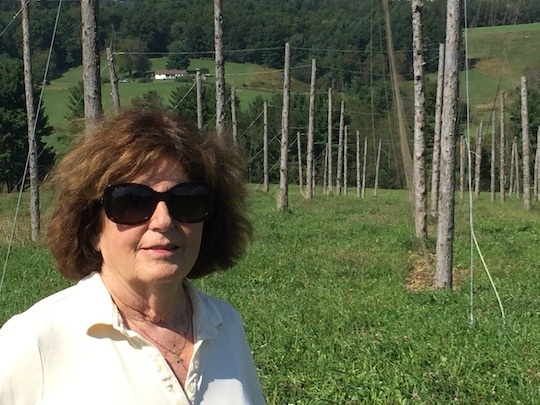
Frances Huber of Brush Creek Farm After her husband died of a debilitating cancer of the spine in 2000, Frances did not want to leave the farm. With her daughter’s help, she opened the land to families and busloads of schoolchildren who visited her newly acquired collection of petting animals. She also created a store and planted a whimsical garden on the farm. While she loved the children who came to visit and learn from her, Frances said, “It was like running Carowinds. Too much.” She laughed.
Now Huber has put her 200-plus acres into conservation easements, including the land that provides the most extraordinary view from her screened porch toward Bullhead Mountain. She then challenged her children to come up with a crop they could raise on a portion of the land. The only requirement was that no chemicals be used in the process. Her son who is a bond trader and her daughter who is in marketing came up with the idea of hops and planted citrus hops from five sources last year on a single acre. “An acre of hops is a lot,” Frances said. “I told them I would give them the rest of that sloping field if it went well.”
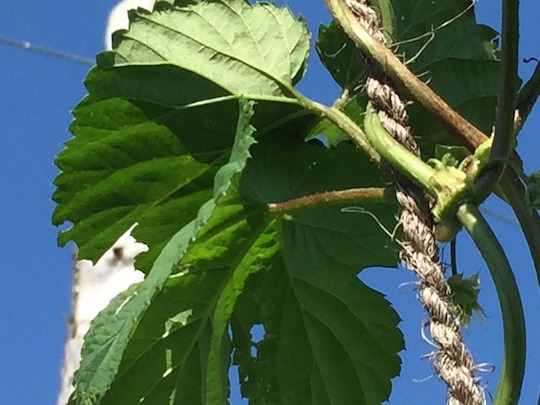
Hops growing on a rope of organic hemp
I had never seen hops growing. Though most of the first crop had been harvested by the time of my visit, a few vines still climbed upward from the ground on organic hemp ropes suspended from wires strung high above on ten-foot poles that were set out in a grid pattern. Clearly the infrastructure for this crop took no small effort to construct. Frances explained that they had to hire a grappler to install the poles while two of her grandsons helped to site and move the heavy poles. Huber’s daughter spent hours digging trenches out of thick sod between poles and amending the soil under the wires where they would plant the ten rows of hops. Each row required constant weeding. The siblings chronicled each variety carefully and found no signs of mildew, though some bugs did come along. They declared the first harvest a success. Frances now admits that she was not sure if the kids would pull it off, but they did. Their new business cards say “Huber Hops.” Perhaps these flavorful ingredients will be coming to a craft brewer near you.
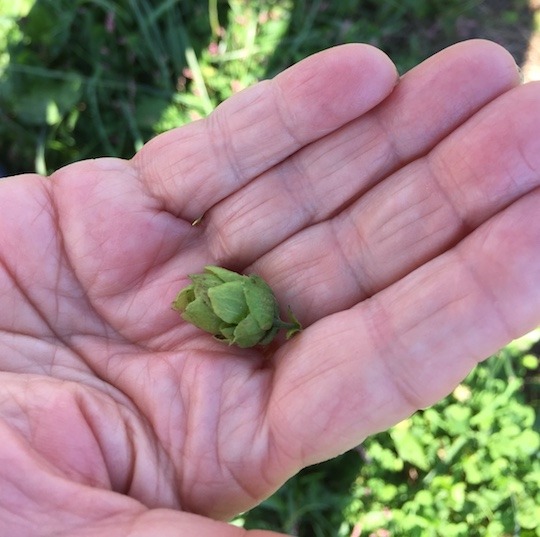
Hops in hand
Two nights later, before I gave a talk about the new book at a farm-to-table dinner for seventy guests in support of the Alleghany Writers’ Development Fund for creative writing in the local schools, I had a chance to sample Frances Huber’s Brush Creek Farm pork tenderloin and chorizo. Local chef Garrison Wagoner used the just-this-side-of-fiery chorizo to stuff succulent mushrooms. It was a most satisfying burn.
The tenderloin served next needed no accompaniment. Huber’s forest-fed pork was like none I have ever had in memory. Soft, sweet, tender, pale, and without any obvious grain in the meat nor toughness. In short, remarkable. A few days later I would hear just the right phrase, supposedly posted outside a BBQ joint in Mississippi—“You don’t need teeth to eat our meat.” That is how tender it was and how easy the visit to this rural enclave. Thanks to Alleghany Writers’ leader Ginger Collins, the Brown family, and Frances Huber for the high-country hospitality.
Need an autographed copy of The Month of Their Ripening for a gift? Write me: georganneubanks9 (at) gmail.com
0 notes
Text
A Sweet Green Kiss
Writer Jim Minick was a featured speaker at the 2018 On The Same Page Literary Festival in Ashe County, NC. He came with a new book to share and a gift of food for all his writer friends. That’s how Jim--who generally eats a plant-based diet--rolls.
When I first met him, Jim and his wife Sarah had sold their pick-your-own blueberry farm in Floyd County, Virginia, which became the subject of his award-winning book, The Blueberry Years: A Memoir of Farm and Family (St. Martin’s/Dunne, 2010). Jim and Sarah next took up residence on a farm near Rural Retreat in Wythe County, Virginia, where he planted 50 new blueberry bushes and harvests apples and other edibles. Though he commutes monthly to Augusta, Georgia, to teach creative writing, Jim has managed to find the time to write an engaging novel about Pennsylvania Dutch farmers and folk healers entitled Fire Is Your Water. It was named best fiction book of the year for 2017 by the Appalachian Writers Association.

Writer and grower Jim Minick. Photo by Chris Arvidson, chrisarvidson.com
As you might surmise, Jim loves the land, homegrown food, and writing about nature. When he pulled several plastic containers out of a wilted brown paper bag after his talk at the Ashe County Library, I thought he had brought his writer friends some green olives. He lifted the lid on one container, and even as I picked up a sample and popped it in my mouth, I still thought it might be an olive with a fragment of the stem intact.
“They’re miniature kiwis,” Jim said, showing his wide, toothy grin that always crinkles the skin on either side of his eyes.
“You grew them?” I asked, still savoring the surprise in my mouth.
“I did.” He said with his usual modesty. “They grow on a vine. They’re almost INVASIVE!”
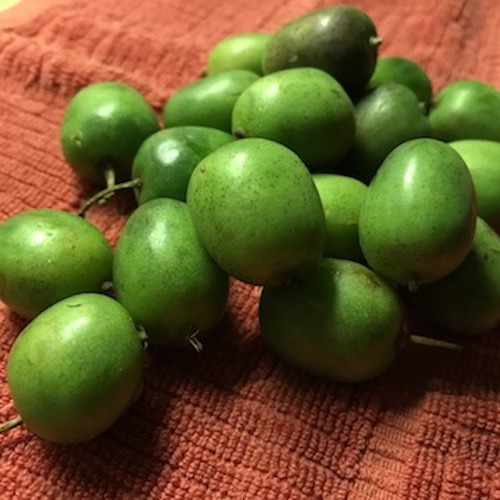
Miniature kiwis Photos by Donna Campbell
I bit a second little kiwi in half. It was like a sweet green kiss on the lips. The smooth, thin skin gave in easily. The crunchy kiwi seeds ran the full length of the oblong fruit. The taste was refreshing--a juicy sweetness that reminded me of my grandfather's Green Gage plums. These kiwis don’t have that pesky sourness or acidity of their larger, fuzzy cousins. Fabulous. I immediately wondered if they’d go well in cocktails--in much the same way we had recently served figs in bubbly Prosecco at my book launch.
Further research reveals that this variety of kiwi--and there are many--is Actinidia arguta, also known as the cocktail or hardy kiwi. It grows in climates as harsh as Siberia’s and can survive temperatures dropping to minus 25 degrees Fahrenheit.

According to the British horticulturalist and foodie James Wong, who grows them in his Croyden garden, the plants will take two to three years to produce fruit, yet by year five, one plant may produce up to 400 fruits. New growth, however, must be pruned back with some vigilance to guarantee maximum sun exposure and to keep the plants bush-like and productive.
Jim set out a pair of kiwi plants—it takes a male and a female to produce fruit-- and four grape plants, all to grow on a stout nine foot tall trellis--high enough to walk under and twelve feet in length. The grapes made a mess, Jim said, and did not prosper without spraying, which he eschews, so he eventually cut them down. The kiwi soon took over the entire trellis, then a nearby sapling, and now Jim has to prop the vines up with two by sixes to keep them accessible for picking and from spreading too far out the sides. “Like a persimmon, the immature fruit will turn your mouth inside out, but it’s best to pick them a little immature and pop them in the fridge,” Jim says. He’s had these kiwis last until Thanksgiving. “You pull them out when you want them, and let them sit a day to ripen up.” The Minicks simply eat them and give them away to friends. They’ve never tried to make pies or cocktails or even smoothies with them.
For information on nutrition, I turned to the website of the George Mateljan Foundation, a nonprofit philanthropic organization that was a valuable resource in my chapter on cantaloupe in The Month of Their Ripening. Mateljan affirms that the more familiar fuzzy kiwi variety--Actinidia deliciosa--is packed with vitamin C and anti-oxidants. It’s a good source of fiber and potassium and is helpful in the control of blood sugar, the prevention of macular degeneration, and the maintenance of both cardiovascular and colon health. A study conducted in Italy found that kiwi consumed with some regularity can also help children with asthma breathe better. Presumably the smaller kiwis have similar benefits. Kiwi fruit grown without the use of pesticides or exposure to heavy metals and certified as organic are best, of course.
Originally called Chinese Gooseberries and first introduced in an American restaurant in 1961, these fruits underwent a name change when an enthusiastic produce distributor claimed to have “discovered” them and began importing them in quantity to the U.S. a year later. The Kiwi, a bird native to New Zealand, became their new namesake, and now, according to the Matjelan Foundation, “Italy, New Zealand, Chile France, Japan and the U.S. are among the leading commercial producers of kiwifruit.”
Cocktail or hardy kiwis are available for fall planting right now from Spring Hill Nurseries in Ohio and come in pairs. The female bears the fruit while the male plant produces variegated leaves, says the website. The Burpee Seed catalog also sells three varieties in four-inch pots, including an extra hardy plant developed at Michigan State that grows as far north as Zone 5. Some fruits turn red; others stay green.
Given the nutritional benefits, I wish I could convince my mountain neighbors to give these expansive kiwis a try in their sunny lower pasture, and I’d help them with the pruning, since the full sun spots in my yard are now quite limited. I asked Jim Minick if he’d plant them again if he had a do-ever. “I would,” he said, “but I’d build an even bigger trellis that was only four feet tall to make the harvesting easier.”
Need an autographed copy of The Month of Their Ripening for a gift? Write me: georganneubanks9 (at) gmail.com
0 notes
Text
Join us for Prosecco and figs
As August wanes, we have some catching up to do. Food Pilgrim has been preparing for the launch of The Month of Their Ripening: North Carolina Heritage Foods though the Year, now available from UNC Press. We’ll be at Malaprop’s Bookstore in Asheville at 4 pm on Saturday, September 1 and BookMarks Festival in Winston-Salem on the 8th with D. G. Martin for a live audience taping of “Bookwatch.” The Piedmont launch of the book is at 3 pm on Sunday, September 9th at McIntyre’s Books in Fearrington, near Pittsboro, NC. Please join us wherever you can. At McIntyre’s we’ll be serving prosecco laced with fig syrup and a windowpane fig slice that was frozen this season from the Celeste figs in my Carrboro garden.

Photo by Donna Campbell
Overall, it was an erratic summer for growing. First it was mercilessly dry in June, and I wondered if the little nubby figs would ever fill out. The deer destroyed the beautiful tomato plants in July, and then the rains came. The figs filled out fast in August, but as happens with cantaloupe, they were watery and not as intensely sweet. “Washed out,” as the farmers in my book would have put it.
So, we have cooked down the watery figs to intensify their flavor for immersion in the bubbly. The August chapter, by the way, is all about figs. September is about scuppernongs, so you will likely see these at other book events later in the month. How can you write a book about North Carolina foods and not come with some samples, right?
In other news, Donna Campbell and I visited novelist Barbara Kingsolver’s restaurant, aptly named Harvest Table. It is on the town square in Meadowview, Virginia, right off I-81 west, just before the Abingdon exit. With a gas-fired pizza oven and lots of local meats, the menu offers a range from simple family fare—burgers and pizza—to several more elegant dishes.
We tried the Sunburst trout filet, dusted with corn meal and pan fried, then placed atop a fresh bed of sunchokes and local wax beans. We also ordered a vegetarian dish of Carolina gold rice (SC) and Sea Island (GA) red peas which were nicely done with the addition of Italian squash, goat cheese, and pickled tomatoes. They were also offering a savory squash, blueberry, peach, and mint gazpacho. The dishes were all very fresh and understated, but we were sad to be the only patrons in the restaurant at the end of their day. The adjacent store, where Kingsolver sells signed copies of her books, also gives local craftspersons an outlet for their wares.
This enterprise is first-rate economic development in a gorgeous Blue Ridge valley, bringing 20,000 visitors yearly and supporting 200 local growers and artisans, the menu said. We bought some fish lure earrings and admired the folk art exhibition and the table arrangements of fresh pink gladiolas, black-eyed Susans, and Queen Anne’s lace. The restaurant, managed by Kingsolver’s husband, Steven Hopp, is now ten years old.
And finally, we were deeply saddened to hear of the total loss by fire of the Cypress Grill, discussed in a Food Pilgrim post back in January. The restaurant was, after all, a fragile wooden shack seasoned with years of boiling grease fumes and tottering on the banks of the Roanoke River in Jamesville. No word yet about plans to rebuild. Honestly, I will miss their meringue-topped pies more than the herring that they deep fried over a four-month window each year, January to April.
0 notes
Text
Here’s the rub
I had a barbecue sandwich last weekend that was moist, smoky-sweet, and clearly not under the vinegary influence of eastern North Carolina. Nevertheless, I was down east, in Columbia--a small village on the banks of the Scuppernong River, about 45 minutes west of Manteo. Columbia is home to the Pocosin Arts School of Fine Craft, where pottery, painting, and metalsmithing are among the classes offered in their waterside studios. Check it out.
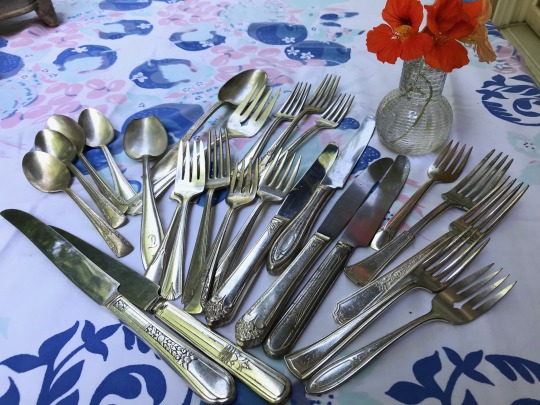
The new/old silverware. Photo by Donna Campbell.
But back to the barbecue. The generously portioned sandwiches--pork or beef brisket--came with a smattering of slaw and were still warm. Turns out they came from a backyard smoker at the Captain's Quarters Inn, a bed and breakfast just across the Albemarle Sound in Edenton. Don and Diane Pariseau have run the B&B for 15 years. They moved to North Carolina from California, where they owned a restaurant in Napa for more than two decades, serving Diane's creations. "California French style, we called it," Don said, when I called him this week. Originally from Massachusetts, the Pariseaus left California and moved east to be closer to their relatives in New England. "But not that close," Don added and laughed. "It's too cold up there."
If you've never been to Edenton, it's a worthy destination with important North Carolina history, including the home of writer Harriet Jacobs, born into slavery in 1813 and whose autobiography, Incidents in the Life of A Slave Girl, tells of her hardships under a master who abused her as a child and later threatened her children. Jacobs would eventually escape to New England after hiding in her grandmother's Edenton attic for seven years. She became a vocal proponent of abolition, and her book was one of the first published by an African American woman in the era. As the first colonial capital of North Carolina, Edenton is filled with graceful architecture and is also home to the oldest courthouse in the state.
So, how did Midwestern barbecue end up as a mainstay in this old Carolina town on the water?
Looking for ways to build up the B&B business, Don Pariseau came up with "Rib University" in 2011. (He has long been a judge for the Kansas City Barbecue Society competitions.) At the high point of Rib U., Don was teaching 260 classes a year. Now he offers his workshop at the Inn on the third Wednesday and Thursday of the month, April through October.
Wednesday night the class begins with a BBQ sauce tasting. The next morning after breakfast, Don discusses different types of smokers, charcoal, and smoking woods, and how to control the temperature of the cooker.
After lighting the smoker, the class samples four different rubs and learns how to break down a slab of ribs and prepare them for the fire. Don cuts his ribs St. Louis style, which means rectangular and flat with the cartilage and breastbone removed. As the spareribs cook all day, participants explore Edenton.
Thursday evening the class reconvenes to sample the various rubs on the ribs, along with sides of slaw, beans, and cornbread. The class is $85 per couple in addition to two nights' lodging at the Captain's Quarters.
Edenton locals also know there's a good chance that Don will be smoking meat most weekends, too. They either smell the smoke or get the word on facebook, and the line forms across his backyard for sandwiches before lunchtime. Such was the origin of the sandwich I had at Pocosin.
On Saturday nights at the B&B, Chef Diane also prepares a prix fixe meal for Inn guests, though sometimes there may be a few extra seats at the table. (Call for reservations.) Don says the first course is generally local seafood, and the rest of the meal will feature in-season items from local farmers or the Pariseau's own garden outside of town. Recently, Diane served locally-raised quail. Don will also take special orders for the cue. He prepared 15 pounds of brisket for a wedding along with 80 sandwiches last weekend.
But here’s the rub. As most folks know, running a B&B is no vacation. It is hard work, and the Captain's Quarters Inn is now on the real estate market. Sadly, as I have learned in my research for a book on North Carolina heritage foods called The Month of Their Ripening (coming out September 4th), the restaurant business is as ephemeral as the seasonal foods I describe in each chapter.
Case in point: yesterday I bought eight place settings from the wonderfully eclectic collection of silver plate that Chef Nate Allen once used at Knife and Fork, the revolutionary restaurant in the mountain town of Spruce Pine that closed at the end of March. Nate's skill in preparing tempura ramps and muddled serviceberries at the bar are both discussed in the book. Now we will have to try to recreate his recipes ourselves. Nate is cooking in the Hamptons this summer.
So if you have a chance to attend Rib University or spend a weekend in Edenton, do it soon and enjoy a little taste of the Midwest in North Carolina's original capital city.
And if you are interested in forging your own utensils, Pocosin Arts is offering a class in July on making spoons for eating ice cream. For real. Visit their catalog here. The teacher is David Clemons, an artist who lives in Arkansas.
NOTE: If you found this blog through a facebook link, please know that you can also sign up for e-mail notification of every posting. You can also unsubscribe at any time. For more information on my book that launches on September 4, please visit my website. A calendar of events related to the book launch is there under BOOK TALKS/WORKSHOPS.
0 notes
Text
A Good Buffet Is Hard to Find
From a food justice perspective, maybe there really is no such thing as a good buffet. The very idea is gluttonous and conspicuously American. "All You Can Eat" or the more delicately put "All You Care to Eat" are slogans only for those who can pay the tab, and who knows how much is left over when food is served in such quantities? From an economic standpoint, serving high quality food at an affordable price and accurately anticipating the number of diners on a given day must always be a tricky proposition, which would explain why so many good Southern buffet restaurants that are not chains don't make it, or the quality of the offerings takes a downward slide.
Still, hunting down a good Sunday buffet was something of a sport in my family. When my mother was still with us, we'd drive more than an hour from Carrboro to Louisburg, on the far side of Raleigh, for a buffet where the spread included a perfect roast beef, hand-carved au jus, fried Carolina shrimp, pork barbecue, pork chops, fried chicken with lots of legs (my favorite), and a dozen fresh vegetables in season. The desserts were still warm just before noon--banana pudding, peach cobbler, apple crisp. Mom loved it, and the price was right. Getting there early, before church was out, was the trick. But the family with the big barn in Louisburg gave up the buffet, and we never discovered its equal elsewhere, though we tried.

If you're heading down I-40 East toward Wilmington, the Meadow Village Restaurant deserves a mention. This modest restaurant is located on Highway 50, which crosses the interstate at the first exit after I-95 near Benson. They offer a lunch buffet Wednesday through Sunday on a stretch of highway that is otherwise rather desolate if you refuse to eat at chains.
Meadow Village provides an embarrassment of options from 11:00 am to 2:30 pm, but getting there early assures a better plate. Fried or boiled shrimp, often oysters, fried catfish, deviled crab, trout, meatloaf, chicken, chicken and pastry, pulled pork, ham, and country fried steak are usually warming at the steam tables. There’s an enormous salad bar, and many of the vegetables are cooked with a heavy hand of sidemeat, though old-fashioned surprises like stewed tomatoes, rutabega, and turnips are also sometimes available.
The dessert bar at Meadow presents whopping cakes and pies that are not pre-cut, but set out whole so that you can serve yourself as little or as much as you dare. These dishes are the only thing that out-sugars the tea. Fair warning: such Eastern North Carolina fare will leave you feeling a good bit heavier than when you arrived.
However, the inspiration for this blog was a recent encounter with some of the best restaurant fried chicken I can remember. The Hitch'n Post in Williamston (right off US 64 at Exit 514 on US 17 Business North) sports a digital sign with a crawling message in big letters. On the day we stopped by, the promotion said something about pimiento cheese sandwiches and soup, but we opted for the lunch buffet, and luckily got there before the Sunday rush.
A week later, with the lingering memory of that crispy-on-the-outside-and unbelievably-moist-on-the-inside-only-white-meat chicken, I decided to call the restaurant. Dale Rodgerson and Eleanor Gardner opened the place in 2005, said Rodgerson, who answered the phone. Both had worked in textile jobs that disappeared, leading them to take the leap into their dream of a restaurant. Rodgerson designed the building, and both owners and their families stained the wood paneling in the dining room. Then they decorated the place with a homespun, cowboy feel. A full buffet is only $12.
When I asked about the cooking, Rodgerson handed the phone to Gardner. Turns out the premium chicken--all breasts and cut into thirds--is sourced from U.S. Foods, a huge private food distributor that also provides the breader. The Hitch'n Post swears by Canola oil for the frying, a somewhat controversial Canadian invention pressed from rape seed.
"Most people use peanut oil to fry chicken," said Gardner, confirming what I've always used, "but we think Canola seals it and gives it a better taste. And we pay a premium price for that oil."
Gardner prepares all the desserts herself, except for the peach cobbler, which she now entrusts to other kitchen staff. To me, the most notable dessert was an orangeish cake, super moist with pineapple, and a coconut icing, which I would have called ambrosia cake, so closely did it hew in taste to my grandmother's once-a-year concoction of fresh oranges, canned pineapple, and coconut for Christmas dinner.
"That's what we call Hawaiian Sunset Cake," Gardner said. (The Hitch'n Post does not allow diners to slice their own portions of dessert, though it is possible to try as many of their servings as you like.)
I learned from later research that this cake has been popular across the state for some time. According to the Shelby Star newspaper, it was all the rage in Kings Mountain, North Carolina, where it enjoyed an 11-year run at the Cup and Saucer Tea Room, before the tragic death of the restaurant's owner. I found a recipe at Taste of Home magazine. It, too, calls for Canola oil!
I asked Eleanor Gardner if the restaurant served anything sourced from local farmers, and she said they definitely buy their sweet potatoes here. (Some of the best in the state, called Covingtons, are grown in this region.) They also get their collards close by and cucumbers "from just up the road." Gardner puts up pickles from the cukes every summer, and uses them for the restaurant's popular chicken and potato salads.
It is not easy to remain buff if you eat one too many buffets, but my search will continue, and I pledge to clean my plate to help avoid food waste. I welcome any discoveries from readers for other places to try.
NOTE: If you found this blog through a facebook link, please know that you can also sign up for e-mail notification of every posting. You can also unsubscribe at any time. For more information on my book that launches on September 4, please visit my website.
5 notes
·
View notes
Text
Of beer cheese and goetta: Food Pilgrim goes to Cincinnati
Cincinnati has a deep association with the production of food. In 1902 Kroger launched their first grocery here, and was the first market to bake their own bread. The city is the birthplace of Crisco--the first hydrogenated vegetable oil, developed from cotton seed in 1911 to replace lard. In 1964, the Kenner Toy Company introduced the Easy Bake Oven to inspire a whole generation of future chefs in the Baby Boom era. Here, too, the art of butchery—mostly of hogs and cattle--was practiced with great pride in the cold weather months of the 19th and early 20th centuries before refrigeration changed the world.

Prepared by Newport native Gary Schultz, goetta tops a casserole of hashed potatoes, eggs, and cheese.
This gritty, post-industrial city was established on the banks of the Ohio and Licking Rivers, a stone’s throw from Kentucky, where goetta—a mealy breakfast sidemeat made from pork parts (including heart and skin), beef, pinhead oats, onions, and secret spices--is still manufactured and bravely consumed.
Goetta’s local power as a nostalgia food has even led to the development of a healthier dopplegänger. Vegan goetta, which I found for sale in Cincinnati’s meat-dominated Findlay Market, is made with pinhead oats, tofu, quinoa, and flax seeds. Glier's Goetta plant, in sight of Cincinnati's skyscrapers but located in Covington, Kentucky, produces more than a million pounds of this slow-cooked concoction each year and retails it in the form of six-pound sliceable slabs and mini-slabs, tubes, burger-sized patties, and "bun links." Glier's has also added a version made from turkey and another that features smoked bacon in the mix. At Findlay Market, a goetta egg roll the size of a burrito was displayed under glass along with the standard slab pictured here.
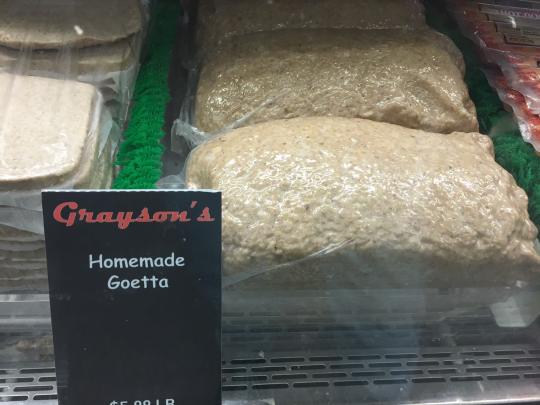
Homemade at the Findlay Market in downtown Cincinnati
Though the nickname “Porkopolis” was not meant as a compliment, Cincinnati earned the moniker in the 1830s because neighboring farmers from the countryside drove their pigs down the streets here all day long toward the Packing House District where they were slaughtered, salted, and stored in barrels, then shipped to points west and south, down the Ohio to the Mississippi River as far as New Orleans. It was a bloody and smelly business mostly carried out by immigrant Germans and Irish, much in the same way that Hispanic immigrants labor in hazardous poultry processing plants in North Carolina today.
The historic neighborhood of Newport on the Kentucky side of the Ohio River was called Bratwurst Row until the Irish moved in, and it was renamed Sausage Row. Now the western shoreline--once notorious for mob-run gambling houses, strip bars, and nightclubs long before Vegas became Vegas--has been transformed into a family friendly destination with greenway bike and walking trails, entertainment and educational venues, chain restaurants, and retail shops.
In Newport I sampled jägerschnitzel at the very first U.S. franchise of Munich’s 400-year-old Hofbrau Haus, famous for its liter-sized mugs of heavy glass or crockery filled with either Ale, Dunkel (dark) or Heifeweizen (wheat-based) beer. This bierhaus was opened in 2003, one of the first steps in the revitalization of Newport. Now the Munich-based mother ship has established additional restaurants in other historic German neighborhoods in Pittsburgh, Cleveland, Columbus, Chicago, and most recently in St. Petersburg, Florida, and in that catch-all, Las Vegas. The schnitzel (pork) was good, the mushroom gravy even better, and the sides of sweet and sour German potato salad and fried cabbage were strong complements.
But before this hefty meal, my native hosts, Roberta and Gary Schultz, and I had to sample the local beer cheese I’d heard so much about, served here with soft, hot, ballpark-sized pretzels.
To my surprise, after dipping a length of pretzel into the small warmed crock of beer cheese, it tasted more like a Swiss fondue--gruyere flavored with white wine—rather than cheddar made spreadable with the addition of beer. Perhaps the taste was to be expected from a recipe created under Bavarian influences instead of the originators of beer cheese some 100 miles to the south in Clark County, Kentucky.
And thus began my research down the rabbit hole of Kentucky beer cheese, a deeply cherished edible memory for many residents of the Bluegrass State, and an elusive and evolving recipe that continues to be the object of much debate and rivalry here.
Kentucky beer cheese is not to be confused with the similarly named Bierkäse, aka Weisslacker—a soft, white, cow’s milk cheese with a strong stench and a mild taste that did originate in Germany. Rather, Kentucky’s beer cheese is a spread first served in the 1940s in Clark County at a restaurant/marina run by Johnny Allman, a former boxer, police officer, and hotel manager who eventually opened his first restaurant on the “wet” side of the Kentucky River near Boonesborough. (Beer could not be served in the county on the opposite shore.) Also known for his catfish and fried banana peppers, Allman reportedly got the recipe for the beer cheese and fried peppers from a cousin who worked as a chef in Arizona.
Allman’s last restaurant in a series in the same general location along the river burned down in 1978. According to Jeffrey Scott Holland writing in Kentucky Monthly, a number of entrepreneurs have since attempted to imitate his original recipe. Then, nearly a decade ago, Johnny Allman’s grandson Ian began offering a grocery store tub that holds fast to his forebear’s recipe, which reportedly requires aged Wisconsin cheddar mashed up with a drizzle of beer until achieving “a richly textured coarseness” with the addition of one or all of these ingredients—garlic, dry mustard, horseradish, onion, and/or cayenne pepper.
The relative proportions required among these ingredients are a subject of ongoing debate in the Bluegrass State. More recent recipes suggest the addition or substitution of Worcestershire, Sriracha or chipotle chili powder.
Hall’s On The River Restaurant, at one time owned by Allman and supposedly lost in a card game, is located upstream from the site of Allman’s last establishment that burned down. Hall’s also lays claim to the origin of beer cheese, by geography if not by precise recipe. They now offer an upscale dining experience along with their own statewide branded label called Hall’s Original Snappy Beer Cheese, all the while careful to give the Allman family their historic due. Apparently, Queen Elizabeth took some Original Snappy home with her after a visit to Lexington some years back--another claim to fame.
At the Beer Cheese Festival held in Clark County each June, contestants vie for bragging rights to the perfect mimicry of Johnny Allman’s original, which was, Holland writes, served in the restaurant “ice cold in white paper cups,” accompanied by packages of wrapped saltines and crudités, such as celery and radish. (There is even some ambiguity in whether said saltines were of the square variety or the sweeter, rectangular Captain’s Wafers.)
The most salient detail, however, is that Johnny Allman reportedly used Pabst Blue Ribbon as the beverage of choice in his spread. Others suggest Kentucky Ale should be the premium ingredient, though Budweiser has also stepped forward to contribute its own recipe on line. Allowing the beer to reach room temperature and go a bit flat before mixing seems to be the only universal requirement.
As I discovered on my 48-hour pilgrimage in the region, the craft beer industry is alive and well in Cincinnati, while Ohio is ranked fourth in the nation in the number of craft barrels produced per year. In Kentucky the growth in craft beer making is also steady, so it’s probably safe to assume that future beer cheese making in either state will reach beyond its roots, what with so many evolving tastes and potential techniques in the mixing of beer and cheese. Still, there are those who pine for the original, says Jeffrey Scott Holland, perhaps in the same way that native Cincinnatians still account for 99 percent of the consumption of goetta.

NOTE: If you found this blog through a facebook link, please know that you can also sign up for e-mail notification of every posting. You can also unsubscribe at any time. For more information on my book that launches on September 4, please visit my website.
0 notes
Text
Adding a little sour to the salad
The crows gathered, chattering in the pine tops this morning as I knelt in the garden and set out a dozen red-veined sorrel plants. I wondered if the crows were plotting to have a taste of the lemony leaf after I left. Sorrel is a member of the buckwheat and rhubarb family, and it served as a flavorful and reliable source of nutrition for the indigenous peoples on this continent for thousands of years before European explorers arrived. The plant is kin to oxalis, the dainty wildflower also known as wood sorrel that blooms yellow, white, pink or red and has three heart shaped leaves joined at their points on the stem. Oxalis, though tiny and fragile, is also edible.
Sorrel comes up in early spring--even in poor soil--and will overwinter or reseed if you let it. With their sharp tang, sorrel leaves can be used to brighten up soups and sauces that are often created with the addition of heavy cream or an abundance of butter and shallots. It's easy to find recipes on line these days that call for sorrel as a congenial ingredient in omelets and tarts, too.
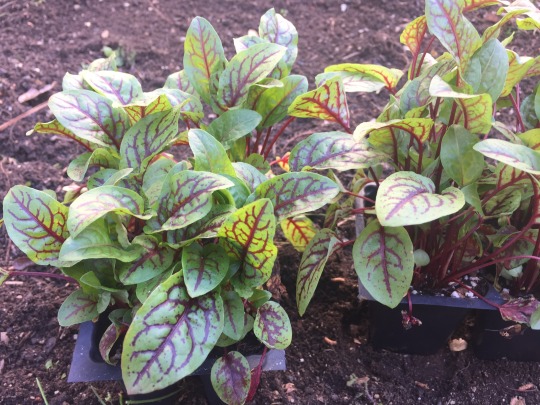
Red-veined sorrel ready for planting as an ornamental or to eat!
Sorrel is an acidic herb. It contains oxalic acid (as does spinach), which can be poisonous to humans if eaten in enormous quantity. You know that sense of something sticking to your teeth when you eat spinach? That fuzzy feeling comes from the oxalic acid in the spinach binding with calcium in your mouth. Fortunately, in addition to vitamins A and C and potassium, sorrel also contains calcium, which actually serves as a foil for the oxalic acid, according to long- ago research on spinach conducted by the famous Duke University biologist Knut Schmidt-Nielsen at the start of his wide-ranging career.
The presence of calcium in sorrel has also made the plant a beneficial ingredient in herbal creams designed to keep wrinkles away and facial skin firm, according to the Australian herb experts John and Rosemary Hemphill, who suggest that sorrel can be used to good effect in a facial steam and "can also be taken as a tea to help clear the skin."
"Sorrel seeds should be sown in March," pronounced Ms. Eleanour Sinclair Rohde in her charming little book, A Garden of Herbs, published in London in 1920 and now available free as an E-book on Google. The ever frugal Ms. Rohde argues that sorrel soup can be made with milk "but is better and cheaper with potatoes." She also mentions--in the archaic spelling of her time--that sorrel can be used "to take Staines out of ones Hands Presently. You may do this with the iuyce [juice] of Sorrell, washing the stained parts therein."
Though March is now past, it is still a fine time to plant sorrel seeds or find plants already started, as I did a few days ago at Big Bloomers Flower Farm in Sanford, North Carolina. Their greenhouses did not yet have the French sorrel (Rumex scutatus) or the common sorrel (Rumex acetosa) potted and ready for sale. And as I have learned in reading, many chefs prefer the French over the common sorrel, since the latter has broad leaves that can get quite large and bitter enough to require blanching before eating.

Oxalis growing wild between the stepping stones in my garden.
The red-veined Rumex sanguineus that I was able to buy (in four packs for $2.95) will make a colorful addition to lettuce salads well into fall if we don't have a major drought. The leaves, best picked small, are tender, lemony, and not too sour. (Sorrel means sour in French.)
I don't remember eating sorrel until the ace cook Jim Harb served it to me in a salad and then shared some seeds. Jim says he routinely combines sorrel from his garden with arugula and mint to make a refreshing first course. "It's just so bright and lemony tart that it picks up any salad," he says.
And here's an expert tip Jim sent along that is also worth considering, regardless of whatever greens you may have on hand: "A secret to luscious salad," he wrote, "is to wet the greens lightly with water. Many people take lettuce straight out of the fridge and dress it. WRONG! The greens need to be wet slightly so that the water can dissolve the salt (which should go on first). Then, comes the acidity [meaning vinegar or citrus juice or both]. If the oil goes on before, the acid can't hit the greens, so only the oil/fat covers the greens. So, water, salt, acid, and then finally oil, in that order."
Thanks, Jim. One more timely fact about sorrel caught my attention. The herb is often served as an accompaniment to fish. Shad--featured in the March chapter of my upcoming book on N.C. heritage foods through the year--are actually swimming upstream right now to spawn in North Carolina rivers. These slab-sided, silvery fish, which are larger than their near-relative the herring, have been much prized by Tar Heels in the past, but they are also known for their prodigious bones.
According to The Oxford Companion to Food, sorrel was often applied as a stuffing for shad, the belief being that the oxalic acid would dissolve the smallest, worrisome bones in the fish as it cooked, not to mention that sorrel's sharp flavor was delicious with this oily fish.
The British food writer and restaurateur Tom Jaine experimented with this theory and found it improbable. Shad bones are better dissolved by prolonged cooking, he discovered.
One last idea: pounding sorrel leaves into a paste with vinegar or lemon juice and a touch of sugar creates what the English back in Ms. Rohde's day rather unromantically called greensauce.
I shall make some greensauce this spring, and I'll let you know how it goes on, say, trout when the time comes.

Sorrel and Bibb lettuce covered in case of visiting crows, deer, or Easter bunnies.
NOTE: If you found this blog through a facebook link, please know that you can also sign up for e-mail notification of every posting. You can also unsubscribe at any time. For more information on my book that launches on September 4, please visit my website.
0 notes
Text
Grow Your Own
In the North Carolina Piedmont, it’s time to plant lettuce. Even with the prediction of light snow in the second week of March, I got a six-pack starter of lettuce transplants and a couple of varieties of seeds to try out. The seed came in handsome packages from Southern Exposure Seed Exchange, a worker-owned co-op in Mineral, Virginia. The company explains that lettuce plants can survive temperatures of 20 degrees Farenheit. Lettuce will come up even when it’s 40 degrees outside though temperatures in the 70s are optimal for seed germination. My hankering for homegrown lettuce was inspired by a bit of history I learned only this week.
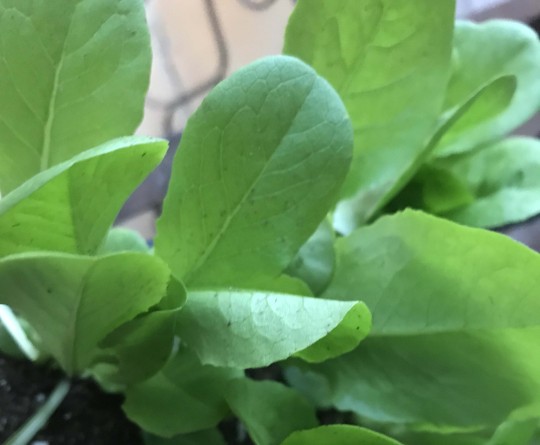
Bibb lettuce from Southern States in Carrboro, NC. Photo by Donna Campbell
While planning an early April trip to Cincinnati for a conference, I was also plotting a food foray across the Ohio state line into Kentucky. My friend Roberta Schultz of Wilder, KY—a brilliant singer/songwriter and occasional basement beer brewer with her husband, Gary--offered to show me around. Roberta, also a faithful reader of this blog, promises we’ll sample beer cheese—a Kentucky dip made with the eponymous ingredients plus garlic and cayenne. She also insists that I sample Goetta--a breakfast protein made of chopped pork, steel cut oats, onions, and broth. Shaped into a brick, Goetta is then sliced into thin slabs and fried, much like the liver mush that’s served in North Carolina--definitely an acquired taste, I’m guessing.
When I googled these items I also discovered that 2018 has been declared “The Year of Kentucky Food,” a campaign to boost tourism, delivered on a website that divides the state into nine regions and regales would-be travelers with descriptions and photos of the state’s most essential dishes. I have already sampled a good many of the esteemed bourbons, and I’ve tried Louisville’s celebrated Hot Brown--an open faced sandwich of turkey topped with mornay sauce. Long ago on a cross country trip, I stopped in the lakes region to sample the local yeast bread baked in flower pots. On another trip we dined at the Colonel’s original KFC--a sit-down restaurant. Then there’s Derby pie and corn pudding--check, check.
I have never tried Kentucky Burgoo (what we might call Brunswick stew here)--a concoction of multiple meats and whatever vegetables might be available to throw in a big iron pot to cook down. Nor have I sampled the mutton barbecue cooked up daily in Owensboro, nor the famous spoon bread served at Berea College. But one native dish from the middle of the state stopped me in my tracks.
Who knew that Bibb lettuce got its name from a Kentucky lawyer and legislator turned horticulturist? John Bibb (1789-1884) served in the War of 1812 and ultimately settled in the state capital of Frankfort, where he bred a sweet lettuce that he called Limestone. Sometime after the Civil War, Bibb began sharing his special lettuce seeds with friends and neighbors, and its popularity grew. A greenhouse in Louisville was selling the seeds far and wide by the 1920s. The inimitable taste of what came to be known as Bibb lettuce, however, turned out to be contingent on its native terroir--namely, central Kentucky’s limestone infused soil which John Bibb obviously understood, having originally named his leaf after the mineral. Though Bibb lettuce had become a national favorite by the middle of the twentieth century, the heirloom leaf was notably fragile and did not travel well.
As the Year of Kentucky Food website explains, Bibb’s tender leaves fell from national prominence in the 1970s when the reign of chains began, and pre-cut salad ingredients were trucked and then laid out under bright lights and sneeze guards in the all-you-can-eat salad bars of budget steak houses. Furthermore, as the website puts it: “With chain groceries opting for prewashed lettuce sold in plastic bags or protective plastic boxes, Bibb’s delicacy again became a liability,”
Bibb lettuce nevertheless remains a local favorite in the Bluegrass State, trotted out especially at Derby time and often served with a signature local dressing known as Benedictine--a fluffy cream cheese concoction that includes cucumber and onion juice. Also served as a spread, Benedictine was invented around 1900 by a Louisville caterer and cookbook author named by Jennie Carter Benedict. (Recipes are easy to find on line.)
The ephemeral quality of Bibb lettuce and its preferred provenance of soil laced with limestone is precisely the kind of food that I write about in my new book, The Month of Their Ripening. It is so rare nowadays that a particular fruit or vegetable can’t be bred to survive shipping across state and national borders to meet our first-world appetites and expectations. Think cantaloupe--so rarely delicious because of premature picking. Yet the geographic limit on true Bibb lettuce is what draws me to it. Though Bibb, like many heirloom vegetables, can be commercially grown organically and hydroponically, experts say that this kind of cultivation just doesn’t carry the same flavor.
Of course, there are other similar varieties—Buttercrisp and Boston, for example—that may be decent approximations. But we are missing John Bibb’s discovery--the candy-sweetness created by a special mineral in the soil, (also an essential part of the story of Doug and Wheeler Munroe’s delicious maple syrup discussed in the previous blog entry.)
Though it may be a fool’s errand, I am planting Bibb lettuce in my garden, and I will apply a bit of lime to try and sweeten the soil. I’ve had the soil tested, and it’s pretty neutral, so we’ll see what happens, if the deer and rabbits don’t beat me to it.
I’ll report back on the Goetta and Beer Cheese in April.
If you found this blog through a facebook link, please know that you can also sign up for e-mail notification of every posting. You can also unsubscribe at any time. For more information on my book that comes out in August, The Month of Their Ripening, please visit my website.
0 notes